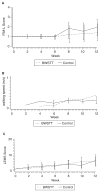The evolution of walking-related outcomes over the first 12 weeks of rehabilitation for incomplete traumatic spinal cord injury: the multicenter randomized Spinal Cord Injury Locomotor Trial
- PMID: 17172551
- PMCID: PMC4110057
- DOI: 10.1177/1545968306295556
The evolution of walking-related outcomes over the first 12 weeks of rehabilitation for incomplete traumatic spinal cord injury: the multicenter randomized Spinal Cord Injury Locomotor Trial
Abstract
Background: The Spinal Cord Injury Locomotor Trial (SCILT) compared 12 weeks of step training with body weight support on a treadmill (BWSTT) that included overground practice to a defined but more conventional overground mobility intervention (CONT) in patients with incomplete traumatic SCI within 8 weeks of onset. No previous studies have reported walking-related outcomes during rehabilitation.
Methods: This single-blinded, randomized trial entered 107 American Spinal Injury Association (ASIA) C and D patients and 38 ASIA B patients with lesions between C5 and L3 who were unable to walk on admission for rehabilitation. The Functional Independence Measure (FIM-L) for walking, 15-m walking speed, and lower extremity motor score (LEMS) were collected every 2 weeks.
Results: No significant differences were found at entry and during the treatment phase (12-week mean FIM-L = 5, velocity = 0.8 m/s, LEMS = 35, distance walked in 6 min = 250 m). Combining the 2 arms, a FIM-L >or= 4 was achieved in < 10% of ASIA B patients, 92% of ASIA C patients, and all of ASIA D patients. Walking speed of >or= 0.6 m/s correlated with a LEMS near 40 or higher.
Conclusions: Few ASIA B and most ASIA C and D patients achieved functional walking ability by the end of 12 weeks of BWSTT and CONT, consistent with the primary outcome data at 6 months. Walking-related measures assessed at 2-week intervals reveal that time after SCI is an important variable for entering patients into a trial with mobility outcomes. By about 6 weeks after entry, most patients who will recover have improved their FIM-L to >3 and are improving in walking speed. Future trials may reduce the number needed to treat by entering patients with FIM-L < 4 at > 8 weeks after onset if still graded ASIA B and at > 12 weeks if still ASIA C.
Figures



References
-
- Dobkin B. The Clinical Science of Neurologic Rehabilitation. New York: Oxford University Press; 2003.
-
- Barbeau H, McCrea D, O’Donovan M, et al. Tapping into spinal circuits to restore motor function. Brain Res Rev. 1999;30:27–51. - PubMed
-
- de Leon R, Hodgson J, Roy R, et al. Locomotor capacity attributable to step training versus spontaneous recovery after spinalization in adult cats. J Neurophysiol. 1998;79:1329–1340. - PubMed
-
- Barbeau H, Nadeau S, Garneau C. Physical determinants, emerging concepts and training approaches in gait of individuals with spinal cord injury. J Neurotrauma. 2006;23:571–585. - PubMed
-
- Dobkin B. Overview of treadmill locomotor training with partial body weight support: a neurophysiologically sound approach whose time has come for randomized clinical trials. Neurorehabil Neural Repair. 1999;13:157–165.
Publication types
MeSH terms
Grants and funding
LinkOut - more resources
Full Text Sources
Medical
Miscellaneous

